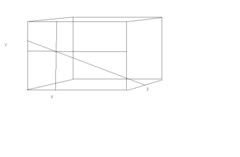So does anybody else want to claim that two intersecting lines create a third line?
Announcement
Collapse
No announcement yet.
8th chevron
Collapse
This topic is closed.
X
X
-
Excuse me ass hole but that is NOT what I ever said. Two intersecting lines make a point on a PLANE. You need the third line to determine the point in SPACE. Jesus, are you just ingnorant by birth or just being an ass?Originally posted by cobraR478So does anybody else want to claim that two intersecting lines create a third line?
Comment
-
Yes you did. You claimed that the intersection of two lines in space would give you two known coordinates, and one variable coordinate. Thus, your "solution set" will be a line.Originally posted by spg_1983Excuse me ass hole but that is NOT what I ever said. Two intersecting lines make a point on a PLANE. You need the third line to determine the point in SPACE. Jesus, are you just ingnorant by birth or just being an ass?
"the diagram you showed has two lines intersecting. one is the y axis, one is the z axis, so where does the point fall on the y axis?"
The lines in my first example moved in all three dimensions of space. Why did you arbitrarily choose 1 dimension as the missing dimension over another?
ROFL
Rep comment:
"f you really went through university level calculus and dont get this then that is a sad statement on your university. As someone that aced university Calculus and Calculus II I find it offensive that you were passed."
Please READ the links I posted. Seriously. If you don't believe me, at least give them a chance.Last edited by cobraR478; 21 March 2006, 07:48 PM.
Comment
-
How 'bout an example with real numbers just for fun.
Lets take the cube example. Lets say the bottom corner in the back is (0,0,0).
Therefore we have lines running from (0,0,0) to (2,2,2) and (0,0,2) to (2,2,0).
In the three-space a line can be represented in this form:
L = P + sv where P is a point and v is a direction vector. s is the parameter.
(I hope you know this or it will be pointless)
Therefore L1 = (0,0,0) + ((2,2,2)-(0,0,0))t = (2,2,2)t
and L2 = (0,0,2) + ((2,2,0)-(0,0,2))s = (0,0,2) + (2,2,-2)s
now setting these equal something becomes apparent:
(2,2,2)t = (0,0,2) + (2,2,-2)s
notice that if we set t=s= (0.5) both sides will be (1,1,1) which is the point of intersection (as I stated earlier)
EDIT:I am somewhat curious how you could Ace University level calculus without knowing that.
EDIT: Again, anybody else want to claim I'm wrong?Last edited by cobraR478; 21 March 2006, 07:53 PM.
Comment
-
Hey, CobraR478, the man is saying that you need 3 coordinates to determine a point in 3D space. What is it that you do you not understand?
That point in space can also be determined by intersecting 2 lines, but that is possible only if you know the coordinates of those lines.
Let's say make it even simpler: you have 2 segments that come from 2 lines. The segments are intersecting. The result is a point in space, but, to know the exact location of that point in space, you must first know where segments 1 and 2 begin and where they end. That means you must now know 4 coordinates in space in order to determine the 5'th one(the intersection point), so you still have to know the positions on X,Y and Z axis.
In conclusion, anyway you put it, in order to determine a point in 3D space, you must have the coordinates on the X,Y and Z axis.
Yay, 100'th post

Comment
-
HAHAHAHAHA! I've just spoted something. You 2 are arguing about 2 different things.
Of course, 2 lines are more than enough. Sorry about the last post, CobraR478Originally posted by CobraR478Have they ever explained why three intersecting lines are needed, and not two?
That has sort of never made sense to me.

I was thinking just like spg_1983. I thought that you meant 2 points in space, not 2 predetermined lines.
You are talking about determining the position of a point in space using 3 coordinates(wich is correct) while CobraR478 was talking about the same thing, but using 2 predetermined lines in space(wich is also correct).Originally posted by spg_1983because space a 3 dimensional reality, not 2. With only 2 line you can calculate the distance on only one plane.
HAHAHAHA, I was reading this thread and I just couldn't believe what I was reading.






Comment
-
WTF , I was wrong again! Please tell me that you meant to say "with only 2 points you can calculate the distance on only one plane"
, I was wrong again! Please tell me that you meant to say "with only 2 points you can calculate the distance on only one plane"
Originally posted by spg_1983because space a 3 dimensional reality, not 2. With only 2 line you can calculate the distance on only one plane.
If not, then I could simply demonstrate that with 2 predetermined lines intersecting in 3D space, one would know the exact position of the intersection point.
Comment
-
And then the guy had the nerve to insult my university for passing me in calculus!Originally posted by PazuzuWTF , I was wrong again! Please tell me that you meant to say "with only 2 points you can calculate the distance on only one plane"
, I was wrong again! Please tell me that you meant to say "with only 2 points you can calculate the distance on only one plane"
If not, then I could simply demonstrate that with 2 predetermined lines intersecting in 3D space, one would know the exact position of the intersection point.
EDIT: I *think* the guy's claim was that if you take two intersecting lines in 3D space, they would only create a point on a plane, not in space, because "They dont have an x, y, and z component, it is only two lines, it is only two axii."Last edited by cobraR478; 22 March 2006, 05:37 AM.
Comment
-
No, you're right! I'm man enough to admit it.Originally posted by wako!I'm not having a massive argument on this, so if you don't beleive it don't beleive it
I made a mistake and I even have a better drawing to make even clearer than you did it. I just don't know how to put it in here. I don't have an address to take it from, it's in my computer.
But...There's always a but ...I wasn't completely wrong because I was saying what I said, thinking that I allready know were the point was( wich is not the case in the stargate location program). I was seeing just the particular case of the problem, when the first 2 lines actually intersected each other(without needing a translation on the 3'rd axis).
...I wasn't completely wrong because I was saying what I said, thinking that I allready know were the point was( wich is not the case in the stargate location program). I was seeing just the particular case of the problem, when the first 2 lines actually intersected each other(without needing a translation on the 3'rd axis).
Yes you do need 3 lines in order to determine the location of that point in space.
Comment
-
You could always make a PhotoBucket account, it lets you upload pictures on the internet for free.Originally posted by PazuzuI made a mistake and I even have a better drawing to make even clearer than you did it. I just don't know how to put it in here. I don't have an address to take it from, it's in my computer.Jedi_Master_Bra'tac, previously known as wako!















Comment
-
I am confused. If you are in 3D space, and draw two lines that intersect, why can't you determine where all three components are? I actually did it in an example in this thread. I've posted links to show you EXACTLY how to do it.. I've done it on tests, quizzes, etc. What's the issue?Originally posted by wako!
With only the X + Y axis, you do not know where it will fall on the Z axis
EDIT: Why do the first two lines HAVE to lie on that plane? Its not like thats ever going to happen in a "real life" example. If a real system worked like the stargate, it would take two lines that almost intersect, somehow calculate exactly where the gate is, and make the connection. It wouldn't take two lines that lie on the wall of some arbitrary box.
By the way, if you know where the plane is, which you could easily calculate with a few points, it would be simple to determine the 3D equation of those lines and calculate all three components of the point anyways.Last edited by cobraR478; 22 March 2006, 12:40 PM.
Comment





Comment